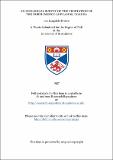Files in this item
An ecological survey of the vegetation of the north mengo lowlands, Uganda
Item metadata
| dc.contributor.advisor | Macdonald, James Alexander | |
| dc.contributor.author | Langdale-Brown, Ian | |
| dc.coverage.spatial | 435 p. | en_US |
| dc.date.accessioned | 2018-06-25T13:25:06Z | |
| dc.date.available | 2018-06-25T13:25:06Z | |
| dc.date.issued | 1957 | |
| dc.identifier.uri | https://hdl.handle.net/10023/14542 | |
| dc.description.abstract | The vegetation of an area of 6000 sq.miles was studied in two stages: 1. a reconnaissance survey of a typical part to obtain general information on the distributions of the communities; 2. detailed investigations of a large number of small areas to obtain data on the interrelations of communities and habitats. The following procedure for mapping vegetation from aerial photographs is described in detail: 1. Stereoscopic interpretation of the aerial photographs. 2. Assembly of the detail to produce semi-controlled mosaics of air-photo patterns. 3. Planning and execution of traverses to sample the vegetation represented by each air-photo pattern. This procedure was used in the Reconnaissance Survey and maps on the scale 1: 50,000 were produced of the vegetation of 800 square miles. It was concluded that the distribution of vegetation types within the reconnaissance area is controlled by topography through its effects on soil type and drainage, and by burning and cutting. The Detailed Investigation was based on the phytosociological and ecological data of 174 sites located throughout the North Mengo Lowlands. It is shown that the distributions of the different communities found in this region are determined by one or more of the following factors: fire and the occurrence of fire breaks; soil type, nutrient status, texture, structure, and drainage; cutting and cultivation; climate; and the degree of uniformity imposed on the environment by the dominant species or the vegetation as a whole. While certain factors control the distribution of each community no one factor or group of factors is responsible for the distributions of all the communities in the North Mengo Lowlands. The distributions of soil types in catenary complexes were noted during the Reconnaissance and were later seen to extend over the whole of the North Mengo Lowlands. The other data of the Detailed Investigation also indicate that the reconnaissance area is typical of the whole region. Comparisons of the data of sites within each of the types mapped during the reconnaissance shown that some of those types are not significantly different either in respect of their communities or their habitats; and also that certain areas have been mapped incorrectly.. However, it is indicated that the 1:50,000 maps could be revised by merging areas of the overlapping types. Modifications to the procedure are suggested to attain greater accuracy. | en_US |
| dc.language.iso | en | en_US |
| dc.publisher | University of St Andrews | |
| dc.subject.lcc | QK966.U6B8 | en |
| dc.subject.lcsh | Plant ecology | en |
| dc.title | An ecological survey of the vegetation of the north mengo lowlands, Uganda | en_US |
| dc.type | Thesis | en_US |
| dc.type.qualificationlevel | Doctoral | en_US |
| dc.type.qualificationname | PhD Doctor of Philosophy | en_US |
| dc.publisher.institution | The University of St Andrews | en_US |
This item appears in the following Collection(s)
Items in the St Andrews Research Repository are protected by copyright, with all rights reserved, unless otherwise indicated.

